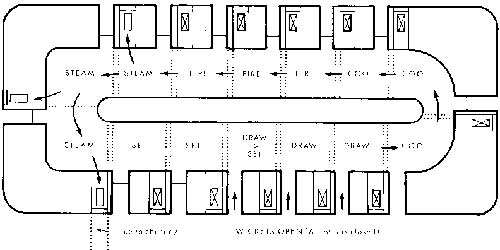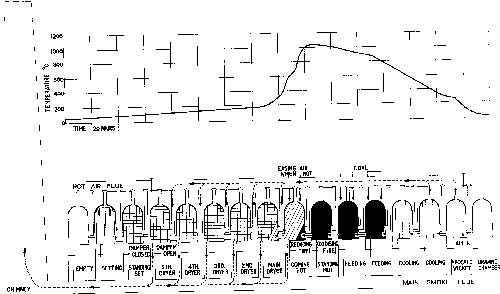The Brickmaking Kiln
- Diagram showing progress of fire within the kiln.
This method requires careful management of the kiln. The chambers are now monitored by computer
as well as the brickworkers. The bungholes in the roof can be opened to view the bricks being fired and add more coal as necessary. Only 0.5 tonne of coal is needed to fire one chamber of bricks. The whole process takes approximately 11 days. Despite it's size and the heat within the kiln can still be affected by the weather. For example,continual heavy rain as experienced this winter can penetrate the brickwork of the kiln itself affecting the firing and the quality of the bricks within.
The advantage of this method of production is that it is continous, bricks being added and removed from the kiln daily. The disadvantage is that the kiln can never go out. The kiln currently in use at Stewartby was lit in 1964 when it was opened and hasn't been out of production since. The use of same basic technology first devised in 1858 today is one of the things that emphasies how rudimentary brick production is. It also shows how important the basic building brick still is to our society despite all the changes that have occurred.
When the Fletton brick industry was in it's infancy open clamp kilns were used to fire the bricks. These were inefficient and meant that the oily fumes given off by the Oxford clay as it burned made the brickmakers unpopular with their neighbours. It is because of an injunction against the Hempsted brothers in 1881 that we know that the first Hoffman kilns were built at the Fletton works.

Over a hundred years has passed since then but the present kiln at Stewartby still follows the basic Hoffman principle. This is a large kiln built with a series of chambers. Flues built within the kiln and controlled by the huge chimney stack on top allows the fire to move gradually around the chambers. This allows the most efficent use of the heat to first dry then fire and cool the bricks
The bricks, still in their 'green' state, are loaded into the chambers by fork-lift trucks. Each chamber holds 64000 bricks. They are carefully stacked to allow for the curve of the kiln roof making most effiocient us of the space. Once loaded in and dried the bricks are sealed into the chamber.with a wicket made of old bricks and a sealant made of brick dust, plaster and cement.
The fire within the kiln is controlled by the flues and gradually reaches the dried bricks. Once the temperature reaches approximately 400 centrigrade the bricks ignite and fire themselves. When the combustible elements with the bricks are burnt off a small amount of coal is added via the bungholes on the top of the kiln to keep the bricks at the correct temperature. While the bricks are being fired the heat can be easily be felt outside of the chamber . Once it is decided the bricks are fired correctly the fire is moved into the next chamber. When the chamber has cooled a little the wicket is broken open and fresh air allowed onto the bricks to finish the process. They are removed by forklift and the chamber is re-filled with 'green' bricks to continue the cycle

